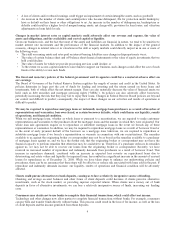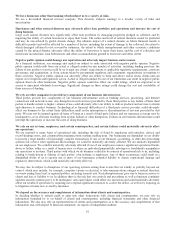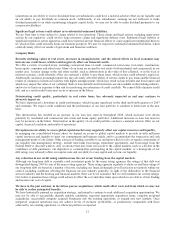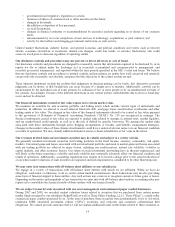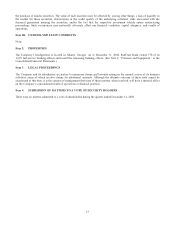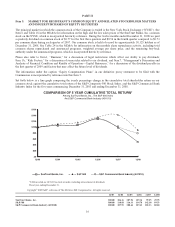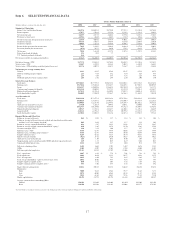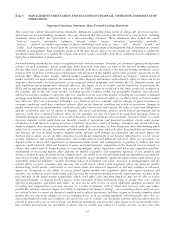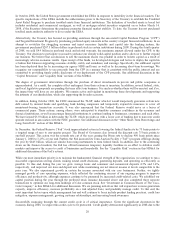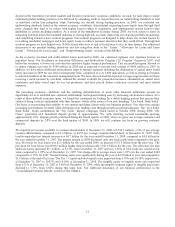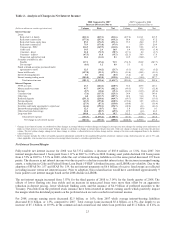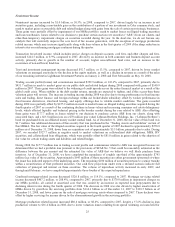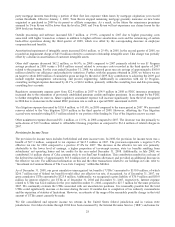SunTrust 2008 Annual Report Download - page 31
Download and view the complete annual report
Please find page 31 of the 2008 SunTrust annual report below. You can navigate through the pages in the report by either clicking on the pages listed below, or by using the keyword search tool below to find specific information within the annual report.transactions with off-balance sheet affiliates or our subsidiaries; and we are subject to market risk associated with our asset
management and commercial paper conduit businesses.
This narrative will assist readers in their analysis of the accompanying consolidated financial statements and supplemental
financial information. It should be read in conjunction with the Consolidated Financial Statements and Notes.
When we refer to “SunTrust,” “the Company,” “we,” “our” and “us” in this narrative, we mean SunTrust Banks, Inc. and
Subsidiaries (consolidated). Effective October 1, 2004, National Commerce Financial Corporation (“NCF”) merged with
SunTrust. The results of operations for NCF were included with our results beginning October 1, 2004. Additionally,
effective May 1, 2008, we acquired GB&T Bancshares, Inc. (“GB&T”) and the results of operations for GB&T were
included with our results beginning on that date. Periods prior to the acquisition date do not reflect the impact of the merger.
In the MD&A, net interest income, net interest margin, and the efficiency ratio are presented on a fully taxable-equivalent
(“FTE”) basis and the quarterly ratios are presented on an annualized basis. The FTE basis adjusts for the tax-favored status
of income from certain loans and investments. We believe this measure to be the preferred industry measurement of net
interest income and it enhances comparability of net interest income arising from taxable and tax-exempt sources. We also
present diluted earnings per common share excluding merger expense and an efficiency ratio excluding merger charges
related to the NCF acquisition. We believe the exclusion of the merger charges, which represent incremental costs to
integrate NCF’s operations, is more reflective of normalized operations. The merger charges related to the acquisition of
GB&T were insignificant. Additionally, we present a return on average realized common shareholders’ equity, as well as a
return on average common shareholders’ equity (“ROE”). We also present a return on average assets less net realized and
unrealized securities gains/losses and a return on average total assets (“ROA”). The return on average realized common
shareholders’ equity and return on average assets less net realized and unrealized securities gains/losses exclude realized
securities gains and losses and the Coca-Cola Company (“Coke”) dividend, from the numerator, and net unrealized securities
gains from the denominator. We present a tangible efficiency ratio and a tangible equity to tangible assets ratio, which
excludes the cost of and the other effects of intangible assets resulting from merger and acquisition (“M&A”) activity. We
believe these measures are useful to investors because, by removing the effect of intangible asset costs and M&A activity
(the level of which may vary from company to company), it allows investors to more easily compare our efficiency and
capital adequacy to other companies in the industry. We also present a tangible common equity to tangible assets ratio which,
in addition to the items described above, excludes the preferred stock. These measures are utilized by management to assess
our financial performance and capital adequacy. We provide reconcilements in Tables 22 and 23 in the MD&A for all
non-U.S. GAAP measures. Certain reclassifications may be made to prior period financial statements and related information
to conform them to the 2008 presentation.
INTRODUCTION
We are one of the nation’s largest commercial banking organizations and our headquarters are located in Atlanta, Georgia.
Our principal banking subsidiary, SunTrust Bank, offers a full line of financial services for consumers and businesses
through its branches located primarily in Florida, Georgia, Maryland, North Carolina, South Carolina, Tennessee, Virginia,
and the District of Columbia. Within our geographic footprint, we operate under four business segments: Retail and
Commercial, Wholesale Banking, Wealth and Investment Management, and Mortgage. In addition to traditional deposit,
credit, and trust and investment services offered by SunTrust Bank, our other subsidiaries provide mortgage banking, credit-
related insurance, asset management, securities brokerage, and capital market services.
EXECUTIVE SUMMARY
During 2008, macro-economic conditions negatively impacted liquidity and credit quality across the financial markets,
especially in the consumer sector, as the U.S. economy experienced a recession. The National Bureau of Economic Research
published a report in December indicating that the U.S. has been in a recession since December 2007 as indicated most
prominently, in their view, by the declining labor market since that time. Since December 2007, in addition to deterioration
in the labor market, the recession has caused rising unemployment, volatile equity markets, and declining home values, all of
which are weighing negatively on consumer sentiment as evidenced by weak spending throughout the year, especially during
the fourth quarter. During the year, financial markets experienced unprecedented events, and the market exhibited extreme
volatility and evaporating liquidity as credit quality concerns, sharp fluctuations in commodity prices, volatility in rate
indices such as Prime and LIBOR, and illiquidity persisted. Concerns regarding increased credit losses from the weakening
economy negatively affected the capital and earnings levels of most financial institutions. In addition, certain financial
institutions failed or merged with stronger institutions and two government sponsored enterprises entered into
conservatorship with the U.S. government. Liquidity in the debt markets was extremely low despite the Treasury and Federal
Reserve efforts to inject capital and liquidity into financial institutions, and as a result, asset values continued to be under
pressure.
19


